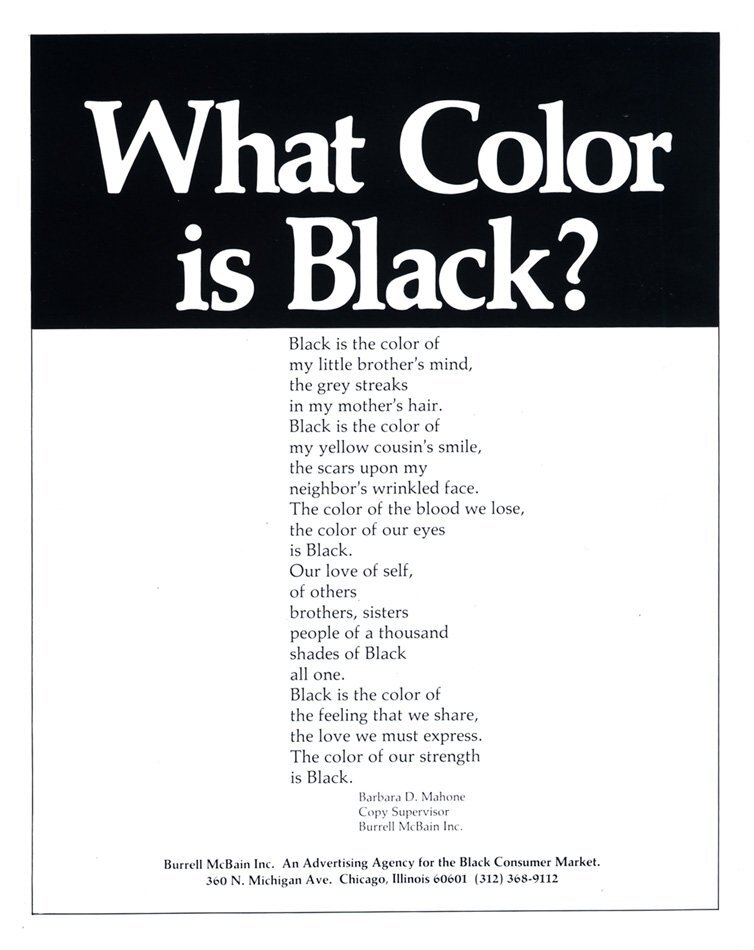Academy Alum Emmett McBain’s work has often been described as “art direction as social equity”. The art director, and co-founder of Burrell-McBain, Inc., was influential in his choice to center Black people and Black life in his advertising campaigns.
McBain attended the Academy in the mid-1950s. After graduating he worked for the newly established Vincent Cullers and Associates, the first Black-owned and Black-focused full-service advertising agency in the United States. Founded in 1958, after years of rejection from white-owned agencies, Cullers created his namesake advertising agency with the purpose of training new Black designers to create ads for Black consumers.
During his time at Cullers, McBain designed his groundbreaking “Black is Beautiful” advertisement and was in charge of the company’s first million-dollar campaign – a new ad for Newport cigarettes targeted at Black audiences. After two years at Cullers, McBain took an assistant art editor position with Playboy Records, leading him to become their promotional art director and carving out a niche as a successful album cover artist. In 1958 his Playboy Jazz All-Stars album art was awarded Billboard Magazine’s Album Cover of the Week.
In 1971, along with Tom Burrell, Burrell-McBain, Inc. was founded. Prior to the 1960s, very little effort was given toward creating advertisements that included and were made for Black communities. McBain and Burrell co-founded their company as “An Advertising Agency for the Black Commercial Market”. Their goal was not to exploit Black Americans but to instead depict authentic images of Black people. One of their most influential ads replaced Marlboro’s white cowboy with a young, cool, and cultured Black man out and about in his community. At the time it was common to simply replace a white actor or model with a Black actor or model in the same ad. This new approach was for more relatable to Black audiences, and thus more successful.
After the wild success of the Marlboro campaign, Burrell-McBain, Inc. won big-name clients like McDonald’s and Coca-Cola and eventually became the largest Black-owned advertising agency in the country.
Academy staff member Don Woodson also worked advertising and considered McBain a mentor. He first learned of the advertising and design legend in the 1970s while attending Ray Vogue, a commercial art and fashion design school in Chicago, in the 1970s. It was there that he first saw McBain’s work for Playboy. When it came time for Woodson to look for a career, a headhunter sent him to interview at Burrell-McBain where he was hired shortly after they won their noteworthy campaign with McDonald’s. Woodson and McBain both lived in Hyde Park at the time and would often spend time chatting about art and advertising after work hours. McBain taught Woodson the important distinction between art direction and illustration, which Woodson carried with him throughout his years working in advertising. He fondly recalls a time when McBain gave him a pencil and a pad of paper and insisted that he draw his portrait without looking down at the paper (known as blind contour drawing). At first Woodson thought he was joking, but soon realized it was a fundamental lesson in actually seeing your subject rather than simply drawing what you know.
McBain eventually left Burrell-McBain, now Burrell Communications, in 1974 to embark on a new career as an artist. He opened The Black Eye, a gallery space and consultancy that advised advertising agencies on how to create stronger connections with the Black community.
Until his passing in 2012, Emmet McBain celebrated Black culture and worked to promote and include the lives of Black people in media. In addition to his advertising work, he also organized nationwide art programs, community projects, and scholarships to uplift Black voices. In 2017, the American Institute of Graphic Arts honored McBain with the AIGA Medal, awarded to designers who have made exceptional contributions to the field of graphic design.

